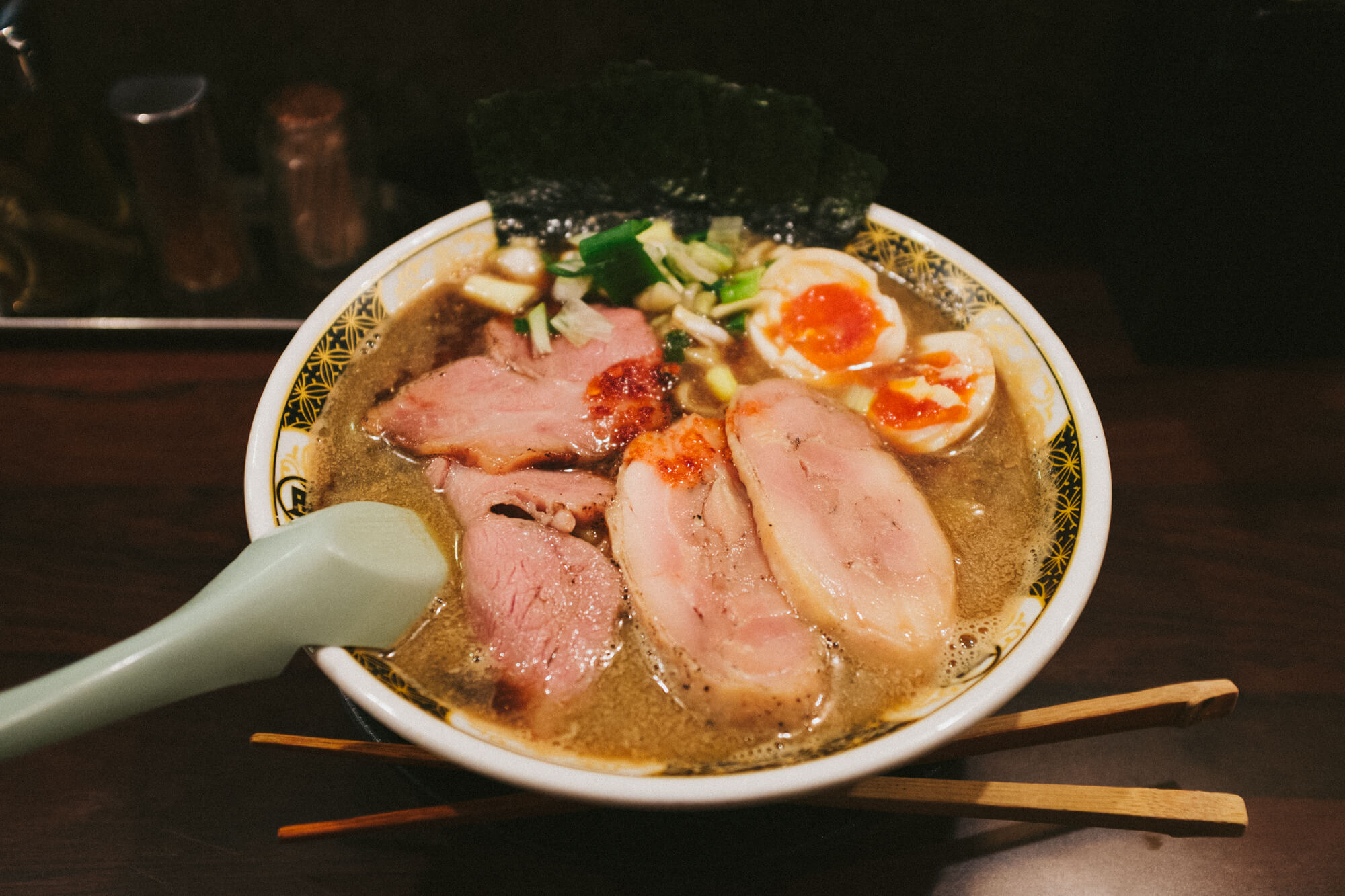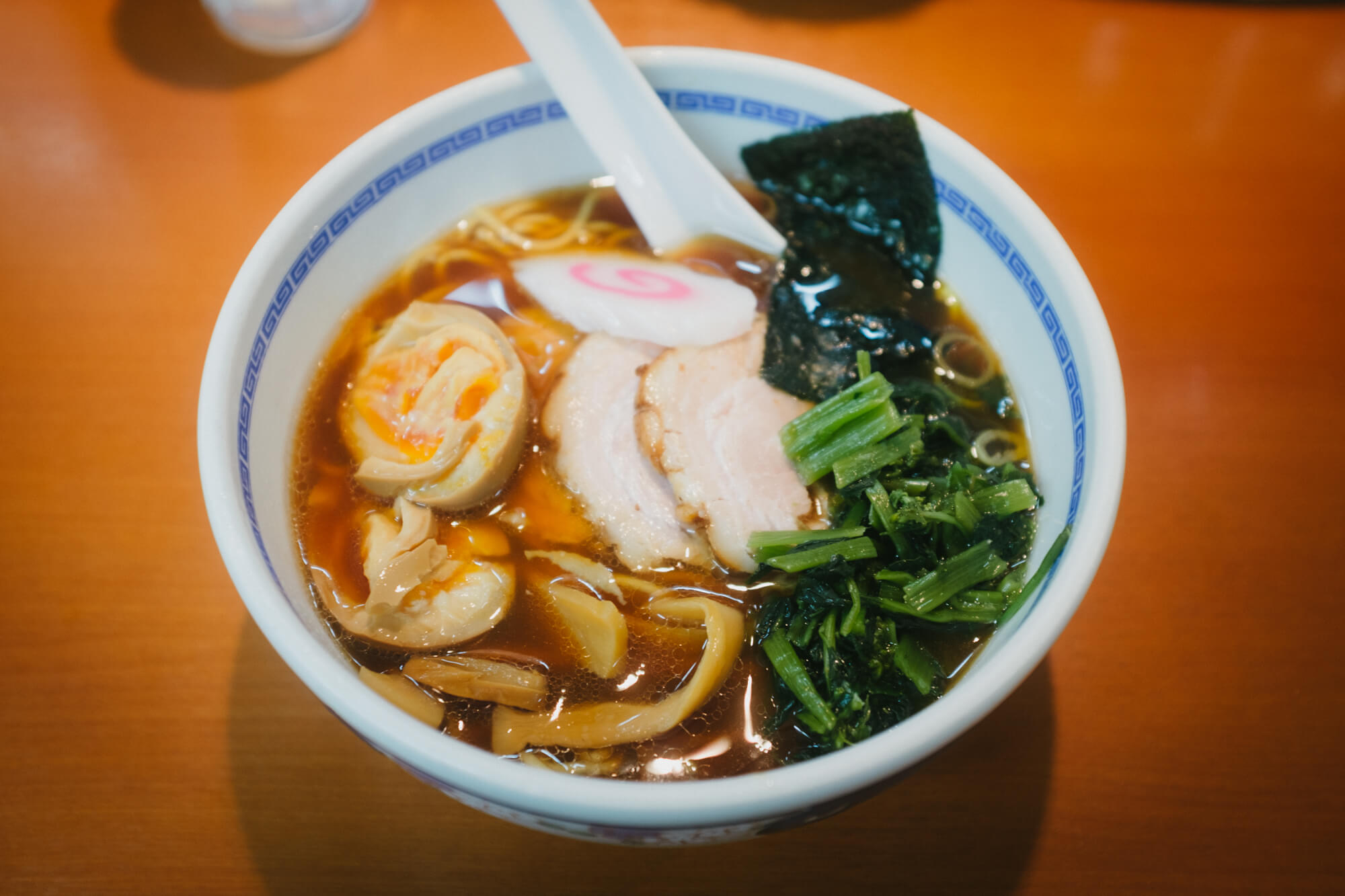Where to Get Fishy Ramen in Tokyo
Eating Niboshi Ramen in Tokyo.
Lucky Peach, November 2016
Download PDF

I was moving to Tokyo and agonized over what my first meal was to be in the weeks leading up to my arrival. I was resetting every other part of my life, so I wanted the first thing I tasted to be distinct. I needed something sumptuous. Not a collection of bites like with yakitori or sushi. I needed something big and heavy and overwhelming. Something satisfying in a way that would soften the wear and tear of transoceanic travel. I needed ramen, and I needed it to be niboshi.
Niboshi ramen is a style that falls outside of the Big Four–shoyu, shio, miso, and tonkotsu. It is the liquid manifestation of dried anchovies. And while you might see a niboshi shoyu or a niboshi shio ramen, these are first and foremost defined by the tiny fish at their base. Small as they are, the flavor the fish carry is both dark and heavy, like a whole school of Maillard reactions that have been corralled and simmered down into a single pot. Niboshi ramen is also distinctly fatty, a gift of the anchovies’ high proportion of natural oil. This is not going to be for everyone. Everyone likes chicken soup, and even more people like pork. That’s part of why ramen has such broad appeal. But a soup that is not just made from, but is a distillation of, something that is considered by most to be either bait or a joke pizza topping? There is a certain “Must-be-this-tall-to-ride” factor.
That was the allure. Not to do something unusual or contrary, but to challenge myself with a flavor that was not always known to be user friendly. Tokyo is a big, unwieldy experience for those just arriving. It was my intention to plunge in as deep as I could and just start swimming from there. I was lucky that the first place I found, Nagi, was so good. Since that first experience, I have sought other bowls like it; often with memorable results, though a few forgettable ones too. The following are the ones I return to most often. Not just because they are delicious, but because they remain something I know I could only have here. Something that belongs to the city. Something that reminds me I belong here too.
Niboshi ramen is a style that falls outside of the Big Four–shoyu, shio, miso, and tonkotsu. It is the liquid manifestation of dried anchovies. And while you might see a niboshi shoyu or a niboshi shio ramen, these are first and foremost defined by the tiny fish at their base. Small as they are, the flavor the fish carry is both dark and heavy, like a whole school of Maillard reactions that have been corralled and simmered down into a single pot. Niboshi ramen is also distinctly fatty, a gift of the anchovies’ high proportion of natural oil. This is not going to be for everyone. Everyone likes chicken soup, and even more people like pork. That’s part of why ramen has such broad appeal. But a soup that is not just made from, but is a distillation of, something that is considered by most to be either bait or a joke pizza topping? There is a certain “Must-be-this-tall-to-ride” factor.
That was the allure. Not to do something unusual or contrary, but to challenge myself with a flavor that was not always known to be user friendly. Tokyo is a big, unwieldy experience for those just arriving. It was my intention to plunge in as deep as I could and just start swimming from there. I was lucky that the first place I found, Nagi, was so good. Since that first experience, I have sought other bowls like it; often with memorable results, though a few forgettable ones too. The following are the ones I return to most often. Not just because they are delicious, but because they remain something I know I could only have here. Something that belongs to the city. Something that reminds me I belong here too.

Nagi
This is the shop (or group of shops) often cited as being on the far end of niboshi possibility. It is also the shop that I ate the aforementioned first bowl at. These days you can choose the strength of your soup, but when I first came here, there was only one way to have it, and it was several degrees heavier and more intense than other places doing niboshi ramen. Tonkotsu gets all the glory for being big and rich and gonzo. But the soup at Nagi ordered at maximum strength is as thick and luscious as a Sunday gravy. Could you sop it with a biscuit? If they sold them, yes you could. The cumulative effect of all the pork, fish, and fat that goes into the soup has a depth that approaches what Cajuns do with gumbo. It would definitely coat a spoon, to say nothing of your arteries.It’s easy to fixate on the broth, but we came here for noodles. House-made noodles. Thick noodles. Nagi uses noodles with bounce, with curves. They have a texture that holds the soup close, the way a serrated knife grabs onto bread. They also toss in a few wide sheet noodles for variation—like finding a few surprise pappardelle in your bowl of spaghetti—so you can slurp in more ways than one. And louder, to boot.
A warning: one of the signature toppings is a small heap of raw onions. You were already going to leave with fish breath, but it will really be fish and onion breath. You will smell pretty, and with all that funky soup and noodles sloshing in your stomach, you’ll feel pretty too. Am I telling you that this isn’t a first date kind of place? No, I’m telling you that if there is a second date after this then you found a keeper.
Nagi Golden Gai
Tokyo, Shinjuku-ku
Kabukicho, 1-1-10

Take-chan
Take-chan is a warm blanket on a cold night. Tucked away half-way down the Keio Line, it is not a destination shop. Even the local ramen cognoscenti tend to brush it off. Is it because it isn’t in the city core? Or is it too old fashioned? Certainly the heyday of the shop has come and gone, as the aging memorabilia on the walls might suggest. But it would be a mistake to write it off just because it isn’t fashionable. Comfort food doesn’t need to be dressed in the latest trends. It just needs to be good consistently. Therein lies the beauty of Take-chan: it’s a taste that is immediately familiar, even if you’ve never been there before. Not as as heavy or bawdy as Nagi. The soup plays at a low hum, like a grandmother singing over the stove. The smoky bitterness of the niboshi is tempered by the fat and soy sauce. A short spoonful of vinegar added at the table lends contrast and complexity. The noodles are thin, but with chew. They taste of satisfaction, not heft.The classic toppings are all accounted for, each being what they are supposed to be. The yolk of the egg is a burnished, molten orange, fudgy in texture. The chashu is tender, almost soft, and its porkiness has been played down instead of up. The bamboo shoots are crunchy. The nori is oceanic. And the naruto is pink, swirly, and perfectly tasteless. Even the option of pickled wasabi greens folds in harmoniously. Nothing tries to achieve dominance beyond the soup and noodles. All the colors are kept inside the lines, and you can just unwind into the food. It’s the ramen you eat when you’re through with the day.
Take-chan Niboshi Ramen
Tokyo, Chofu-shi
Fuda, 1-47-1

Saru-Suberi
Saru-Suberi, whose name could be translated as either crape myrtle or sliding monkey, is a case study in a unique Tokyo aesthetic. Housed in a basement two stories below a Shinjuku department store, it falls decidedly in the category of Off the Map. Street level signage notwithstanding, the casual eater will not be stumbling into this shop. You are there because you knew it is where you wanted to be.The low-slung counter is surrounded by worn stools. J-pop, at once incongruous and the only appropriate choice, is almost always playing on the stereo. I often imagine it serving as backdrop to some grizzled anime anti-hero interlude. Black coat, tired eyes, cigarette permanently dangling from his lips. He’s drifted down from the bustling streets above to eat this bowl of fishy tsukemen, as a moment’s reprieve from the before and after.
There are plenty of options and pictures of those options, but the simplest bowl here seems to be the most fitting. No adornments or superfluous distractions. The presentation is unpretty, just a dark, unctuous gravy whose treasures have all retreated deep within. And yet, once you dunk the first noodles into that rich morass, the layers of the soup are immediately apparent. With the first slurp, your tongue is quickly coated with an intense sensation of smoke and char. Two bites in and the ashy sweetness of roasted onions has overrun you. Several spoonfuls of fried garlic push it all even farther. And a dash of vinegar pulls it into a full three dimensions. It is a host of flavors that are going to linger long after the meal is over. When you reemerge into the frenzy above, people will know what you did. But wear your funk proudly. You wouldn’t be digging for ramen on level B2 if you were going to be ashamed of your choices.
Saru-Suberi
Tokyo, Shinjuku-ku
Shinjuku, 3-4-8 Frente B2
